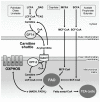Lipotoxicity in Kidney, Heart, and Skeletal Muscle Dysfunction
- PMID: 31330812
- PMCID: PMC6682887
- DOI: 10.3390/nu11071664
Lipotoxicity in Kidney, Heart, and Skeletal Muscle Dysfunction
Abstract
Dyslipidemia is a common nutritional and metabolic disorder in patients with chronic kidney disease. Accumulating evidence supports the hypothesis that prolonged metabolic imbalance of lipids leads to ectopic fat distribution in the peripheral organs (lipotoxicity), including the kidney, heart, and skeletal muscle, which accelerates peripheral inflammation and afflictions. Thus, lipotoxicity may partly explain progression of renal dysfunction and even extrarenal complications, including renal anemia, heart failure, and sarcopenia. Additionally, endoplasmic reticulum stress activated by the unfolded protein response pathway plays a pivotal role in lipotoxicity by modulating the expression of key enzymes in lipid synthesis and oxidation. Here, we review the molecular mechanisms underlying lipid deposition and resultant tissue damage in the kidney, heart, and skeletal muscle, with the goal of illuminating the nutritional aspects of these pathologies.
Keywords: kidney; lipotoxicity; sarcopenia; skeletal muscle; uremia.
Conflict of interest statement
The authors declare no conflicts of interest.
Figures


Similar articles
-
Lipotoxicity and Diabetic Nephropathy: Novel Mechanistic Insights and Therapeutic Opportunities.Int J Mol Sci. 2020 Apr 10;21(7):2632. doi: 10.3390/ijms21072632. Int J Mol Sci. 2020. PMID: 32290082 Free PMC article. Review.
-
Renal lipotoxicity: Insights from experimental models.Clin Exp Pharmacol Physiol. 2021 Dec;48(12):1579-1588. doi: 10.1111/1440-1681.13556. Epub 2021 Sep 23. Clin Exp Pharmacol Physiol. 2021. PMID: 34314523 Review.
-
Lipotoxicity-related sarcopenia: a review.J Med Life. 2022 Nov;15(11):1334-1339. doi: 10.25122/jml-2022-0157. J Med Life. 2022. PMID: 36567835 Free PMC article. Review.
-
Hypercaloric Diet Promotes Metabolic Disorders and Impaired Kidney Function.Curr Pharm Des. 2022;28(38):3127-3139. doi: 10.2174/1381612829666221020162955. Curr Pharm Des. 2022. PMID: 36278446 Review.
-
Emerging roles of ER stress and unfolded protein response pathways in skeletal muscle health and disease.J Cell Physiol. 2018 Jan;233(1):67-78. doi: 10.1002/jcp.25852. Epub 2017 May 16. J Cell Physiol. 2018. PMID: 28177127 Free PMC article. Review.
Cited by
-
Uremic Sarcopenia: Clinical Evidence and Basic Experimental Approach.Nutrients. 2020 Jun 18;12(6):1814. doi: 10.3390/nu12061814. Nutrients. 2020. PMID: 32570738 Free PMC article. Review.
-
Kidney Damage Caused by Obesity and Its Feasible Treatment Drugs.Int J Mol Sci. 2022 Jan 11;23(2):747. doi: 10.3390/ijms23020747. Int J Mol Sci. 2022. PMID: 35054932 Free PMC article. Review.
-
Metabolic Reprogramming and Renal Fibrosis.Front Med (Lausanne). 2021 Nov 8;8:746920. doi: 10.3389/fmed.2021.746920. eCollection 2021. Front Med (Lausanne). 2021. PMID: 34859009 Free PMC article. Review.
-
Lipid Toxicity in the Cardiovascular-Kidney-Metabolic Syndrome (CKMS).Biomedicines. 2024 Apr 29;12(5):978. doi: 10.3390/biomedicines12050978. Biomedicines. 2024. PMID: 38790940 Free PMC article. Review.
-
Simvastatin reduces chronic kidney disease and renal failure risk in type 2 diabetes patients: post hoc ACCORD trial analysis.Diabetol Metab Syndr. 2024 Nov 14;16(1):272. doi: 10.1186/s13098-024-01514-6. Diabetol Metab Syndr. 2024. PMID: 39543671 Free PMC article.
References
Publication types
MeSH terms
Grants and funding
LinkOut - more resources
Full Text Sources
Medical

